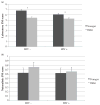An examination of the age-prospective memory paradox in HIV-infected adults
- PMID: 21992453
- PMCID: PMC3327134
- DOI: 10.1080/13803395.2011.604027
An examination of the age-prospective memory paradox in HIV-infected adults
Abstract
The age-prospective memory (PM) paradox asserts that, despite evidence of age-associated PM deficits on laboratory tasks, older adults perform comparably to (or better than) young adults on naturalistic PM tasks. This study examined the age-PM paradox in older HIV-infected individuals, who represent a growing epidemic and may be at heightened risk for adverse neurocognitive and everyday functioning outcomes. Participants included 88 older (50+ years) and 53 younger (≤40 years) HIV-infected individuals as well as 54 older and 59 younger seronegative adults who completed both laboratory and naturalistic time-based PM tasks. Similar interactions were observed in both the seropositive and the seronegative samples, such that the older participants demonstrated significantly lower laboratory-based PM than the younger groups, but not on the naturalistic PM trial. Secondary analyses within the HIV+ sample revealed that naturalistic task success was indirectly associated with greater self-reported use of PM-based and external compensatory strategies in the daily lives of older, but not younger, HIV+ adults. Study findings suggest that, although older HIV-infected adults exhibit moderate PM deficits on laboratory measures versus their younger counterparts, such impairments are paradoxically not evident on ecologically relevant naturalistic PM activities in daily life, perhaps related to effective utilization compensatory strategies.
Figures


References
-
- American Psychiatric Association. Diagnostic and statistical manual of mental disorders. 4. Washington, DC: Author; 1994.
-
- Bailey PE, Henry JD, Rendell PG, Phillips LH, Kliegel M. Dismantling the “age-prospective memory paradox”: The classic laboratory paradigm simulated in a naturalistic setting. Quarterly Journal of Experimental Psychology. 2010;63:646–652. - PubMed
-
- Castellon SA, Hinkin CH, Myers HF. Neuropsychiatric disturbance is associated with executive dysfunction in HIV-1 infection. Journal of the International Neuropsychological Society. 2000;6:336–347. - PubMed
Publication types
MeSH terms
Grants and funding
LinkOut - more resources
Full Text Sources
Medical
